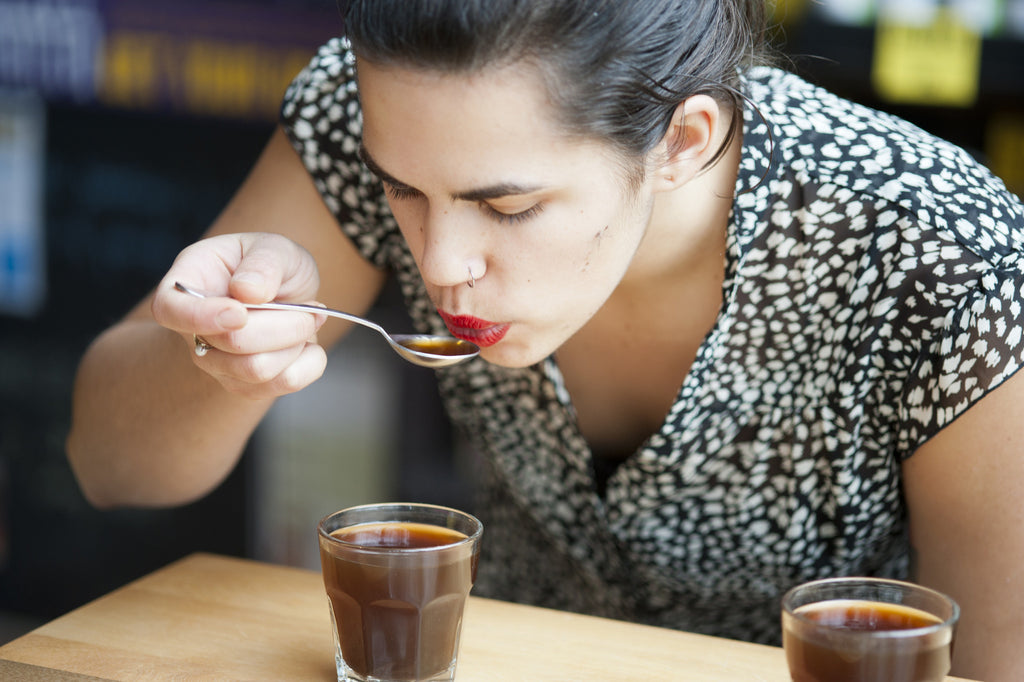
Cupping is the process used in the coffee industry to evaluate the aroma and taste of coffee. Here at HG, we cup coffee for several reasons, including staff and partner education, quality control, palate development, and to determine what specific flavor notes should be listed on our labels.
In order to maintain consistency with coffee professionals nationally, we follow the coffee cupping protocol set by the Specialty Coffee Association (SCA). Here’s the rundown:
Before evaluating, take note of:
1. Roast date
2. Lot numbers (which indicate cooperative ID, harvest year, and harvest sequence)
All cupping cups used should be the same size and dimensions (ours are clear glass, 7 oz). The ratio of coffee to water should be 1.63 grams (whole bean) per 1 fluid ounce of water.
1. Measure 11.41 grams whole bean coffee for each sample.
2. Grind coffee (medium-coarse setting) directly into cupping cups (purge between varieties).
3. Within 15 minutes after samples have been ground, the dry fragrance of the samples should be evaluated by sniffing the dry grounds.
4. Pour water (200 degrees) over grounds to saturate grounds and fill cup.
5. Leave coffee to extract for 3 minutes.
6. Break the crust by stirring 3 times, then allow the foam to run down the back of the spoon while gently sniffing. Rate fragrance/aroma on the basis of dry/wet evaluation.
7. When the sample has cooled to 160º F (71º C), after 8-10 minutes from infusion, evaluate the taste. Aspirate (slurp) into the mouth in such a way as to cover as much area as possible, especially the tongue and upper palate. Rate flavor/aftertaste.
8. As the coffee continues to cool (160º F - 140º F), rate acidity, body and balance. Balance is how well the flavor, aftertaste, acidity, and body work together in harmony.
9. As the brew approaches room temperature (below 100º F), rate sweetness, uniformity, and clean cup.

We score the following variables using the official SCA cupping form, shown above. The following explanations of cup components are slightly adapted from the World Brewers Cup Rules and Regulations:
1. Dry fragrance
2. Wet aroma
Generally speaking, the range of the coffee’s aromatic character corresponds to the origin of coffee. In contrast, the intensity of aromatic character generally relates to the freshness of a coffee, as measured by the length of time between roasting and brewing and depending on the type of packaging used to provide moisture and oxygen protection for the beans.
3. Flavor
Flavor represents the coffee's principal character, the "mid-range" notes, in between the first impressions given by the coffee's first aroma and acidity to its final aftertaste. It is a combined impression of all the gustatory (taste bud) sensations and retro-nasal aromas that go from the mouth to nose. The score given for Flavor should account for the intensity, quality and complexity of its combined taste and aroma, experienced when the coffee is slurped into the mouth vigorously so as to involve the entire palate in the evaluation.
4. Aftertaste
Aftertaste is defined as the length of positive flavor (taste and aroma) qualities emanating from the back of the palate and remaining after the coffee is expectorated or swallowed. If the aftertaste were short or unpleasant, a lower score would be given.
5. Acidity
Acidity is often described as "brightness" when favorable or “sour” when unfavorable. At its best, acidity contributes to a coffee's liveliness, sweetness, and fresh fruit character and is almost immediately experienced and evaluated when the coffee is first slurped into the mouth. Acidity that is overly intense or dominating may be unpleasant, however, and excessive acidity may not be appropriate to the flavor profile of the sample. The final score marked on the horizontal tickmark scale should reflect the judge’s perceived quality for the Acidity relative to the expected flavor profile based on origin characteristics and/or other factors (degree of roast, intended use, etc.). Coffees expected to be high in Acidity, such as a Kenya coffee, or coffees expected to be low in Acidity, such as a Sumatra coffee, can receive equally high preference scores although their intensity rankings will be quite different.
6. Mouthfeel/Body
The quality of Body is based upon the tactile feeling of the liquid in the mouth, especially as perceived between the tongue and roof of the mouth. Most samples with heavy Body may also receive a high score in terms of quality due to the presence of brew colloids and sucrose. Some samples with lighter Body may also have a pleasant feeling in the mouth, however. Coffees expected to be high in Body, such as a Sumatra coffee, or coffees expected to be low in Body, such as a Mexican coffee, can receive equally high preference scores although their intensity rankings will be quite different.
7. Balance
How all the various aspects of Flavor, Aftertaste, Acidity and Body of the sample work together and complement or contrast to each other is Balance. If the sample is lacking in certain aroma or taste attributes or if some attributes are overpowering, the Balance score would be reduced.
8. Overall
The “overall” scoring aspect is meant to reflect the holistically integrated rating of the sample as perceived by the individual judge. A sample with many highly pleasant aspects, but not quite “measuring up” would receive a lower rating. A coffee that met expectations as to its character and reflected particular origin flavor qualities would receive a high score. An exemplary example of preferred characteristics not fully reflected in the individual score of the individual attributes might receive an even higher score. This is the step where the judges make their personal appraisal.
